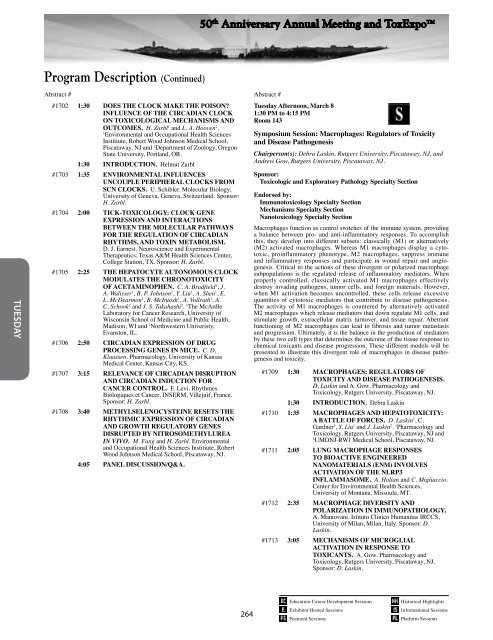Program - Society of Toxicology
Program - Society of Toxicology
Program - Society of Toxicology
You also want an ePaper? Increase the reach of your titles
YUMPU automatically turns print PDFs into web optimized ePapers that Google loves.
50 th Anniversary Annual Meeting and ToxExpo<br />
<strong>Program</strong> Description (Continued)<br />
Tuesday<br />
Abstract # Abstract #<br />
#1702 1:30 DOES THE CLOCK MAKE THE POISON?<br />
INFLUENCE OF THE CIRCADIAN CLOCK<br />
ON TOXICOLOGICAL MECHANISMS AND<br />
OUTCOMES. H. Zarbl 1 and L. A. Hooven 2 .<br />
1<br />
Environmental and Occupational Health Sciences<br />
Institiute, Robert Wood Johnson Medical School,<br />
Piscataway, NJ and 2 Department <strong>of</strong> Zoology, Oregon<br />
State University, Portland, OR.<br />
1:30 INTRODUCTION. Helmut Zarbl<br />
#1703 1:35 ENVIRONMENTAL INFLUENCES<br />
UNCOUPLE PERIPHERAL CLOCKS FROM<br />
SCN CLOCKS. U. Schibler. Molecular Biology,<br />
University <strong>of</strong> Geneva, Geneva, Switzerland. Sponsor:<br />
H. Zarbl.<br />
#1704 2:00 TICK-TOXICOLOGY: CLOCK GENE<br />
EXPRESSION AND INTERACTIONS<br />
BETWEEN THE MOLECULAR PATHWAYS<br />
FOR THE REGULATION OF CIRCADIAN<br />
RHYTHMS, AND TOXIN METABOLISM. <br />
D. J. Earnest. Neuroscience and Experimental<br />
Therapeutics, Texas A&M Health Sciences Center,<br />
College Station, TX. Sponsor: H. Zarbl.<br />
#1705 2:25 THE HEPATOCYTE AUTONOMOUS CLOCK<br />
MODULATES THE CHRONOTOXICITY<br />
OF ACETAMINOPHEN. C. A. Bradfield 1 , J.<br />
A. Walisser 1 , B. P. Johnson 1 , Y. Liu 1 , A. Shen 1 , E.<br />
L. McDearmon 1 , B. McIntosh 1 , A. Vollrath 1 , A.<br />
C. Schook 2 and J. S. Takahashi 2 . 1 The McArdle<br />
Laboratory for Cancer Research, University <strong>of</strong><br />
Wisconsin School <strong>of</strong> Medicine and Public Health,<br />
Madison, WI and 2 Northwestern Univeristy,<br />
Evanston, IL.<br />
#1706 2:50 CIRCADIAN EXPRESSION OF DRUG<br />
PROCESSING GENES IN MICE. C. D.<br />
Klaassen. Pharmacology, University <strong>of</strong> Kansas<br />
Medical Center, Kansas City, KS.<br />
#1707 3:15 RELEVANCE OF CIRCADIAN DISRUPTION<br />
AND CIRCADIAN INDUCTION FOR<br />
CANCER CONTROL. F. Levi. Rhythmes<br />
Biologiques et Cancer, INSERM, Villejuif, France.<br />
Sponsor: H. Zarbl.<br />
#1708 3:40 METHYLSELENOCYSTEINE RESETS THE<br />
RHYTHMIC EXPRESSION OF CIRCADIAN<br />
AND GROWTH REGULATORY GENES<br />
DISRUPTED BY NITROSOMETHYLUREA<br />
IN VIVO. M. Fang and H. Zarbl. Environmental<br />
and Occupational Health Sciences Institiute, Robert<br />
Wood Johnson Medical School, Piscataway, NJ.<br />
4:05 PANEL DISCUSSION/Q&A.<br />
Tuesday Afternoon, March 8<br />
1:30 PM to 4:15 PM<br />
Room 143<br />
Symposium Session: Macrophages: Regulators <strong>of</strong> Toxicity<br />
and Disease Pathogenesis<br />
Chairperson(s): Debra Laskin, Rutgers University, Piscataway, NJ, and<br />
Andrew Gow, Rutgers University, Piscataway, NJ.<br />
Sponsor:<br />
Toxicologic and Exploratory Pathology Specialty Section<br />
Endorsed by:<br />
Immunotoxicology Specialty Section<br />
Mechanisms Specialty Section<br />
Nanotoxicology Specialty Section<br />
Macrophages function as control switches <strong>of</strong> the immune system, providing<br />
a balance between pro- and anti-inflammatory responses. To accomplish<br />
this, they develop into different subsets: classically (M1) or alternatively<br />
(M2) activated macrophages. Whereas M1 macrophages display a cytotoxic,<br />
proinflammatory phenotype, M2 macrophages, suppress immune<br />
and inflammatory responses and participate in wound repair and angiogenesis.<br />
Critical to the actions <strong>of</strong> these divergent or polarized macrophage<br />
subpopulations is the regulated release <strong>of</strong> inflammatory mediators. When<br />
properly controlled, classically activated M1 macrophages effectively<br />
destroy invading pathogens, tumor cells, and foreign materials. However,<br />
when M1 activation becomes uncontrolled, these cells release excessive<br />
quantities <strong>of</strong> cytotoxic mediators that contribute to disease pathogenesis.<br />
The activity <strong>of</strong> M1 macrophages is countered by alternatively activated<br />
M2 macrophages which release mediators that down regulate M1 cells, and<br />
stimulate growth, extracellular matrix turnover, and tissue repair. Aberrant<br />
functioning <strong>of</strong> M2 macrophages can lead to fibrosis and tumor metastasis<br />
and progression. Ultimately, it is the balance in the production <strong>of</strong> mediators<br />
by these two cell types that determines the outcome <strong>of</strong> the tissue response to<br />
chemical toxicants and disease progression. These different models will be<br />
presented to illustrate this divergent role <strong>of</strong> macrophages in disease pathogenesis<br />
and toxicity.<br />
#1709 1:30 MACROPHAGES: REGULATORS OF<br />
TOXICITY AND DISEASE PATHOGENESIS. <br />
D. Laskin and A. Gow. Pharmacology and<br />
<strong>Toxicology</strong>, Rutgers University, Piscataway, NJ.<br />
1:30 INTRODUCTION. Debra Laskin<br />
#1710 1:35 MACROPHAGES AND HEPATOTOXICITY:<br />
A BATTLE OF FORCES. D. Laskin 1 , C.<br />
Gardner 1 , Y. Liu 1 and J. Laskin 2 . 1 Pharmacology and<br />
<strong>Toxicology</strong>, Rutgers University, Piscataway, NJ and<br />
2<br />
UMDNJ-RWJ Medical School, Piscataway, NJ.<br />
#1711 2:05 LUNG MACROPHAGE RESPONSES<br />
TO BIOACTIVE ENGINEERED<br />
NANOMATERIALS (ENM) INVOLVES<br />
ACTIVATION OF THE NLRP3<br />
INFLAMMASOME. A. Holian and C. Migliaccio.<br />
Center for Environmental Health Sciences,<br />
University <strong>of</strong> Montana, Missoula, MT.<br />
#1712 2:35 MACROPHAGE DIVERSITY AND<br />
POLARIZATION IN IMMUNOPATHOLOGY. <br />
A. Mantovani. Istituto Clinico Humanitas IRCCS,<br />
University <strong>of</strong> Milan, Milan, Italy. Sponsor: D.<br />
Laskin.<br />
#1713 3:05 MECHANISMS OF MICROGLIAL<br />
ACTIVATION IN RESPONSE TO<br />
TOXICANTS. A. Gow. Pharmacology and<br />
<strong>Toxicology</strong>, Rutgers University, Piscataway, NJ.<br />
Sponsor: D. Laskin.<br />
264<br />
Education-Career Development Sessions<br />
Exhibitor Hosted Sessions<br />
Featured Sessions<br />
Historical Highlights<br />
Informational Sessions<br />
Platform Sessions
















